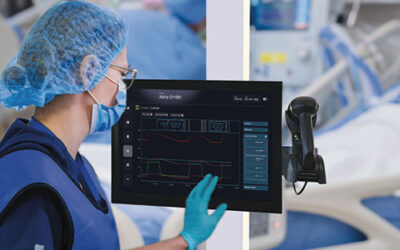How to Leverage Digital Tools to Reduce Burnout and Improve Employee Satisfaction
Healthcare is in the throes of an employee burnout crisis — and the numbers are nothing short of alarming. According to a survey in the Journal of General Internal Medicine, nearly half of healthcare workers have experienced burnout. Nursing appears to have the highest rate of burnout at 56%. Physicians haven’t fared much better (47.3%), nor have “other” clinical staff (54.1%), especially in IT and support staff. Even more troubling, however, is the intent to leave. The number of nurses who reported a conscious and deliberate desire to find other employment came in at 41%. Roughly a quarter of physicians felt the same.
Much of the burnout centers on work overload, and while healthcare has always been demanding, it’s only gotten more taxing over the last few years. Not only have workers been putting in longer hours with increasing administrative demands, but they’ve also been struggling to achieve a good work-life balance, access mental health services, and obtain the necessary support from their leadership teams. Ever-evolving tech also means more training hours for physicians and a heavy workload for IT staff. Complicating matters further has been the increasing number of verbal and physical attacks by patients. It’s no wonder why nurses, physicians, and other clinical staff are experiencing everything from exhaustion and workplace-related anxiety to emotional detachment and even compassion fatigue.
In fact, a survey by PureSpectrum found that 58% of clinicians have lost their passion for their careers due to stress. But stress is only part of the problem. Another aspect at play is the patients. With all the misinformation shared about COVID-19 over the last few years, 65% of clinicians believe patients have less trust in medical professionals, making their work more challenging than ever before.
Further reading: Telehealth Technology Helps Prevent Nurse Burnout — Here’s How
The industry is looking at the perfect storm — one that’s already led to nearly 20% of healthcare workers leaving the field and left many organizations questioning how to fix staffing shortages in healthcare. Only time will tell what the long-term effects of this mass burnout will be, but one thing is for certain: Hospitals, clinics, and other medical facilities must start investing in initiatives for reducing burnout in healthcare. Otherwise, there won’t be enough doctors, nurses, and other clinical staff to provide proper care, which would inevitably lead to a decline in patient satisfaction and outcomes.
Reevaluating the makeup of your workforce and looking at innovative care delivery models can certainly help. Research from the Association of American Medical Colleges suggests that the industry will be facing a shortage of anywhere from 37,800 to 124,000 physicians over the next decade. Part of improving the health system moving forward is making sure to implement the right technology that will help streamline workflows or automate workload instead of adding burden to staff. Here are some things to consider.

Implementation: Exploring IT Solutions for Healthcare
Implementing IT solutions for healthcare may sound fairly straightforward. Find a product that fills a gap and then roll out the technology. However, people (as you very well know) are often resistant to change, even when that change is of benefit to the work that they do each day. It all starts with finding the right solution that fits within an existing workflow — a solution that’s not only intuitive and easy to use but causes minimal (if any) disruptions or deviations to processes, routines, and most importantly the quality of care delivery. Even the smallest of hiccups could negatively impact adoption rates.
Take, for example, automation in healthcare. Advancements in technology have brought the likes of artificial intelligence, remote patient monitoring, the digital analysis of medical scans for cancer diagnosis, the simple collection and processing of patient data to improve care delivery, and so on — all of which have the potential to improve patient outcomes, save time and money, and reduce the burden on employees.
However, the integration process can be a stumbling point for many organizations, even though digital transformation in healthcare has been going on for a decade or more. It often calls for special attention to detail and dedicated support to ensure a smooth and seamless transition — otherwise, those tried-and-true workflows that many providers rely on could suffer cracks that can erode the continuity and quality of care.
Nurses, in particular, may be reluctant to adopt a new system or digital tool if it comes with any kinks, as they’re already juggling both medical and administrative responsibilities. Whatever solution is introduced must immediately demonstrate its value or risk being seen as more work with no resolve.
As you begin to explore the options, the first order of business will be to vet potential Telehealth partners and ensure that the digital solution doesn’t upend any workflows, processes, or routines. Are they equipped to help you make the transition as smooth and seamless as possible? How much IT infrastructure is needed, and what existing technology can you leverage? What level of support and training will be offered during the transition? Then, all the other questions can be asked about security, interoperability, usability, customization, and whatever else you’d like to know.
For more information on what to ask potential partners, may we suggest reading: 4 Questions to Ask Before Partnering with a Telemedicine Tech Provider
Education: Key to a Successful Digital Transformation of Healthcare
Even with the best IT solutions for healthcare, organizations can struggle with integration, and what’s often lacking is proper training for both staff and patients. Whether working for your organization or seeking care services, people will require education on how Telehealth works, patient expectations, and what staff and patients can gain from the new solution. There’s no getting around this fact.
Chances are good that part of the onboarding process will include some type of training program, but it’s still important to ask potential vendors what their onboarding process entails and the timeline. Are training sessions conducted in person, provided via pre-recorded videos and online tutorials, or virtual training? Will someone be made available for questions, support, and additional training if needed for new staff? Obviously, you’ll want modules that can be included in the training process for new team members that can be used for any ongoing training requirements or support. So, make sure to inquire about that, too.
Team members can also benefit from doing a test run on the new Telehealth system prior to using the technology. No matter how thorough, training will only take a person so far. Consider conducting a few mock trials to test out the different connection methods, features, and various uses of the solution. Doing so will get employees comfortable with the technology and help build their confidence prior to use.
How you go about conducting test runs is entirely up to you, but we’ve found that staff often respond positively to mock system tests at the program’s endpoints. We’ve also seen positive results when organizations set up a technology lab within their facility for team members to go through training modules and “play” with the equipment and technology. A devoted space allows people to practice and reduce the chance of error when the system actually goes live, thereby improving the patient experience.
Once team members are familiar with the new system, it can also be beneficial to experience the platform on the patient side of care. What sort of experience is the system delivering for patients? The Northwest Regional Telehealth Resource Center recommends that during telemedicine training for physicians, nurse care coordinators, and other healthcare providers, workers should visit network sites to experience the conditions on the other end of care. It can provide a different perspective on the challenges or issues that could occur if something were to go wrong on their end.
Learn more about integrating IT solutions for healthcare with: Telemedicine for Beginners: How to Introduce Staff to Telehealth
Outcomes: What to Expect When Using Digital Tools Correctly
Whether it’s automation in healthcare or virtual care technology, the implementation process can feel daunting. But when done correctly, Telehealth solutions can be of significant benefit to the well-being of healthcare workers and patients alike.
For one, it can improve the overall work environment and employee satisfaction by providing greater flexibility with tasks and responsibilities. That flexibility is often felt by patients, too. Just consider the barriers to care that some people experience: travel, work, children, and so on. No longer are they held back by an in-person office visit and long wait times. It can now be done virtually at a time that works best for them.
In fact, a “virtual-first” approach to care could be the answer for many organizations questioning how to fix staffing shortages in healthcare. The patient’s care journey could start online and be used as a means for assessing their precise needs prior to determining the best form of care. Will a virtual visit serve their needs? Could an initial assessment be done by a clinician who visits the home and connects to a remote specialist? Should they come in for an appointment? What will be most appropriate going forward? Virtual-first care (or virtually assisted care) both streamline care delivery and improves access to care.
Improving access for patients also has a way of reducing clinician burnout. When leveraging virtual tools and technology, you can serve a much wider patient population, all while maximizing your workforce time and managing their needs. More importantly, specialists will now have a means for serving patient communities across multiple locations. This, too, can be of great benefit to patients and providers, improving both access and quality of care.
Case in Point: CETF Improves Quality of Care at Skilled Nursing Facilities
Skilled nursing facilities are no strangers to challenges. CETF can certainly attest to that. When COVID hit, new procedures began to put a strain on staff, prompting a rise in employee burnout and turnover. A stronger Telehealth solution quickly became a necessity. The problem was physicians were already taking on more and more work, leaving little room to learn and use new technology. The organization needed a new strategy if it had any hope of bringing Telehealth further into their communities.
CETF decided the only means of doing so was to enlist the help of experts on not only Telehealth technology but also its implementation and training. The first order of business would be getting buy-in from its team, as large-scale changes can be difficult for employees — even more so for those reporting burnout. Implementation and training would also need to be customized to the facility if the organization expected team members to adopt the new technology. A more personalized approach would help build trust in the system and demonstrate its value to patient care and efficiency.
The move paid off, and staff adoption improved exponentially.
Learn more about CETF’s Customer Success Story
Making the Right Choice in a Telehealth Technology Provider
Digital transformation of healthcare may be well underway, but it doesn’t take away from the fact that choosing the right Telehealth solutions is key. It will help shape how your healthcare organization moves forward in care delivery by not only improving access to care services but also taking some of the burden from healthcare workers. As you look ahead and work toward instituting initiatives to combat employee burnout and improve employee satisfaction, IT solutions for healthcare could be the missing piece of that puzzle.
If you’d like to learn more about what AMD can do to improve care delivery, contact us today. Our team can help you find the technology solution perfectly suited to your organization’s needs.





